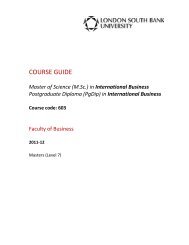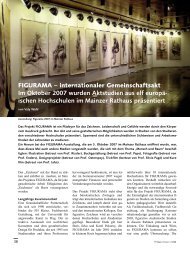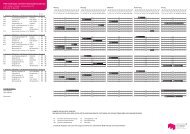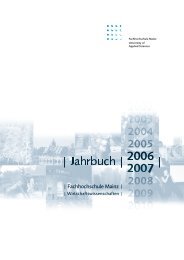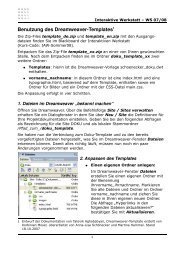Fachhochschule Mainz University of Applied Sciences
Fachhochschule Mainz University of Applied Sciences
Fachhochschule Mainz University of Applied Sciences
Sie wollen auch ein ePaper? Erhöhen Sie die Reichweite Ihrer Titel.
YUMPU macht aus Druck-PDFs automatisch weboptimierte ePaper, die Google liebt.
22 | Auslandsbeziehungen |<br />
Ten Steps <strong>of</strong> Efficient International Market Research<br />
Pr<strong>of</strong>. Dr. Kurt Scharnbacher<br />
Most managers recognize the need for domestic<br />
marketing research – the single most<br />
important cause for failure in international<br />
marketing and market places is insufficient<br />
preparation and information. Mistakes <strong>of</strong>ten<br />
occur, because managers, firms and companies<br />
do not have enough information and<br />
therefore they <strong>of</strong>ten do not have an adequate<br />
understanding <strong>of</strong> the new international markets<br />
and the business environment. Building<br />
a good knowledge base is the key issue for<br />
subsequent and efficient market presence<br />
and success.<br />
1. Step: Defining the issue<br />
We need a definition <strong>of</strong> market research.<br />
Market research is <strong>of</strong>ten defined as the<br />
„systematic and objective identification, collection,<br />
analysis and dissemination for the<br />
purpose <strong>of</strong> improving decision making related<br />
to the identification<br />
and solution <strong>of</strong> problems<br />
and opportunities<br />
in marketing“. This definition<br />
states the need<br />
for systematic work,<br />
indicating that market<br />
research should be the<br />
result <strong>of</strong> planned and organised activity. It<br />
points out the need <strong>of</strong> objective information<br />
and stresses that subjective opinions are not<br />
very important. Market research must have<br />
a business purpose and international market<br />
research must be linked to the decision making<br />
process within the management strategy.<br />
2. Step: Tools and Techniques <strong>of</strong> International<br />
and Domestic Market Research<br />
The general opinion is, that tools and techniques<br />
<strong>of</strong> international marketing research<br />
are exactly the same as those <strong>of</strong> domestic<br />
marketing research – the only thing that<br />
differs is the environment. But – because<br />
this environment differs, the execution <strong>of</strong><br />
international marketing research differs as<br />
well. The tools may be the same but the<br />
primary differences are the new parameters<br />
and the new environment which increases<br />
the number <strong>of</strong> important factors to be considered.<br />
„It has long been an axiom<br />
<strong>of</strong> mine that little things<br />
are the most important.“<br />
Sherlock Holmes<br />
In crossing a national border, the company<br />
is faced with new parameters such as different<br />
law and duties, foreign currencies and<br />
changes <strong>of</strong> their value, international documentation,<br />
different modes <strong>of</strong> transportation<br />
and others – these are parameters not found<br />
in domestic market research.<br />
The new environment is, that firms have<br />
to learn about the culture and habits <strong>of</strong><br />
the host country. They have to understand<br />
the countries policy system and its societal<br />
structures and <strong>of</strong> course the different language.<br />
This means, that all the results and<br />
assumptions, which were formulated over<br />
years for the domestic market must be re-evaluated.<br />
Going international, the firm exposes itself to<br />
a greater variety <strong>of</strong> competition than in<br />
the domestic market.<br />
As a result, the numbers<br />
<strong>of</strong> factors involved<br />
are increasing.<br />
3. Step: The Needs<br />
and Benefits <strong>of</strong><br />
Research<br />
Managers <strong>of</strong>ten tend to assume, that their<br />
methods are the best and the most acceptable<br />
to all others. Fortunately this is not<br />
true – how boring the world would be, if<br />
there were no differences. But – not aware<br />
<strong>of</strong> this differences, firms are not very willing<br />
to spend money on research and to find<br />
out about these differences. Often, the companies<br />
are not familiar with international<br />
sources <strong>of</strong> information and therefore not able<br />
to use them. But – to serve a market very<br />
efficiently and to benefit from a international<br />
market – firms must learn what the customers<br />
want, why they want it and how to serve<br />
their needs and demands.<br />
4. Step: Research Objectives<br />
Because <strong>of</strong> the different strategies in management<br />
and the market situation, research<br />
objectives will vary from firm to firm. In<br />
international market research, the most frequent<br />
objective is the analysis <strong>of</strong> the opportunities<br />
the foreign market <strong>of</strong>fers.<br />
Jahrbuch Wirtschaftswissenschaften | FH <strong>Mainz</strong> | 2002




